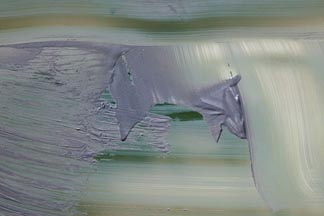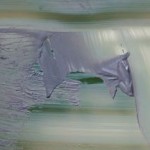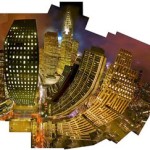“Where’s the Marketing Department?” “Is your office over there, Tim?” I naughtily quipped. The grey grid pattern of endless squares on every single surface of the museum spoke more to the corporate world than the art world, more Microsoft than Magritte. We both felt that as monumental and attractive as the buildings are, the architecture doesn’t seem to invite visitors to see the art within its walls but in some cases discourages trespass with its impractical or non-existent signage and floor plan. It was never very easy to find exhibitions.
Tim, a creative/account director in the advertising industry, and I saw another giant in L.A, the much-ballyhooed Getty Center. Somehow I was expecting the curved cutting edge of Frank Gehry’s architectural hand as Tim and I wound up the hill of The Getty Center in the monorail. Lodged in the back of my head was the perception that Mr. Gehry was the brains behind this mammoth museum building that overlooks a king-sized chunk of L.A. and the Pacific Ocean from its mountainous perch.
That said I especially enjoyed seeing one room filled with fairly large Gerhard Richter paintings. His strokey paintings, both delightfully spontaneous and rationally calculated, always get me in the gut. The sprawling exhibition of the photography of the Berman Collection was never overly daring but some gems stood out. It was great to see a night-exposure Christmas tree image by Somerville resident Mary Kocol exhibited as the centerpiece in one room and included in the Getty collection. Mary brought her talent for flashlight photography to excited students in my Abstraction Made Elementary public art project.
After the Getty, I then dragged Tim to take me to see Bergamot Station in Santa Monica, a coterie of contemporary galleries conveniently laid out industrial-style on one large block of asphalt and warehouses buildings. At the Craig Krull Gallery we both enjoyed the visual splash of the Palette Series by Robert Weingarten, large colorful photographs of the painting palettes of various “important living painters” taken at a nose hair’s distance. Weingarten, whose work I found also represented at Weston Gallery in Carmel, made photographs that resemble abstract paintings themselves with some correlation to the artists’s style. A few were a bit blurred; the sharpest images were the strongest.
-
While I am always glad to see more risky and even risqué work than safer commercial art, we bickered about the merits of certain contemporary art that is more conceptual – or requires more reading and homework. Tim brought me down to (his) reality often enough, wittily sizing up the show with mostly hysterical on-site commentary buoyed by a growing impatience and been-there-done-that dismissal of several shows. In one gallery, we found ourselves in a darkened room, with a circular video projection of Arabic typography spinning around and around in a whirling dervish accompanied by a repetitive mantra-like score. Lo and behold, I turned to Tim to find him with arms extended forward in Frankensteinian stance as he walked trance-like toward the hypnotic imagery on the wall.
One Bergamot gallery, IKON Ltd., specializes in secondary-market, blue-chip artists such as Haring, Kruger, Warhol, Rauschenberg, Lichtenstein, Ruff, Basquiat, and de Kooning. I was intrigued by the 6-foot tall spin art made in Mexico by Damien Hirst and thought there must be more of a story somewhere, somehow about his splatter painting made long after Pollock. But the idea that names sometimes mean so much over quality in the art world troubled me, too. I mentioned to the gallery dude that a friend told me his uncle had invented the spin art machine (a novelty of amusement parks in the 70s, probably my first entry into abstraction). Impressed with their inventory of artists, I jokingly chided Tim as the director looked on and asked him if he could make a certain piece (maybe it was the spin art). “I could do everything here,” he brazenly responded. I chuckled a tad but remained a bit embarrassed.
Do we make such an impolite stink over other non-purchased products and services as we are nearly obliged to do with contemporary art in our culture? Do we stand in diva-like indignation in the middle of the grocery aisle and point to packaging that looks wack or dated and let the manager know what we think of this logo here or this syrup bottle design there? What more can we do with our cutting edges to not “enlighten” the masses but encourage a dialogue, more discussion, about contemporary art – even with those such as my highly accomplished, well-educated friend who let his Artforum subscription lapse long ago?
We continued our feisty disagreements by phone a few days after I returned to Boston. Tim proposed that I like “everything,” while I questioned his intellectual stamina. The idea that you can learn something even from bad art remains with me from my college years. After a brief but whirlwind dive into a mixed bag of hits and misses in the larger fish bowl of L.A, I do think that “provincial” Boston has a very rich curatorial and architectural resource thus far in the new ICA. “One small step for...” Oh I’ll stop.
The whole “art imitates life” quandary hit me as I experienced these glorious scenes in person once again but which unfortunately reminded me of kitschy paintings, too. Many years ago, my father had heroically driven me (for several hours at night, mind you) on this extreme route on our trip to explore California Institute of the Arts (CalArts) in Valencia and the San Francisco Art Institue when I was between schools. Dad and I ate brunch and I had my first taste of Kona coffee at the same resort where Madonna and Sean Penn honeymooned, overlooking sumptuous cliffs on the Pacific. In Frisco we saw B.B. King live.
The Hearst Castle, now a tourist destination under California State Parks, is simply a must-see for architectural, design, art, and society fans of all stripes. Our tour guide expounded on the multiple pursuits of William Randolph Hearst, whose visionary charm and ambition late in his life created a home that challenges the glitz and and by far rivals the smaller size of Newport mansions and somehow more modestly and thoughtfully displays its rare antiquities, Renaissance painting, and Spanish medieval ceilings. Needless to say, Patty Hearst was not on guard duty that day.
We then got a guided tour of Ron and Ken’s more favored galleries during the monthly Thursday Night gallery night. At the Peter Blake Gallery, the painter Andy Moses does blue and tan, horizontal space and lines, in a gorgeous, technically sweet manner. My cutting edges, finely honed at Ron and Ken’s home and elsewhere in CA, were smoothed a bit in the more commercial galleries of Laguna (and later in Carmel). But I did have a nice conversation with a painter about the French influence (Bonnard, Corot, Courbet) in his work exhibited in his gallery. My biggest regret is not making it to the Laguna Art Museum to see the grand, digitally mastered, bulging city - and landscape photography of Jeremy Kidd.
L.A., and less so general American culture, has a Goth thing going on, a subconscious surging and submerging of our violent times. The Abbey’s post-religious décor, giant hearth, and medieval-mod atmosphere echoes the Gothic feel of other cultural highlights there. It was majestically present in the not-so-current but historic Hearst Castle. I was intrigued when the Chrome Hearts gal told us that Cher’s compound of a home has the skull-and-cross-bonish touch of Mr. Stark. Later in my strolls through a majority of the nearly 30 galleries in Culver City, the go-to area for newness, I saw several painting shows that had a macabre feeling.
I got more than my Omen fix in the paintings of David Stoupakis’s show entitled “Sheep Will Follow,” with his paintings framed by 20-feet of heavy, dark curtain hanging from the ceiling in an over-the-top fashion. The technical and narrative strengths of his work were tamed in softly penciled and less successful drawings.
I was lucky to meet some gracious artists in Culver City. A lovely artist/dancer couple moved to L.A. from New York and now live an oddly “quiet” life in the isolated pockets spread out in this vast, car-cramped metropolis. They are co-owners of the Mandrake, a cleanly designed bar and gallery for the art set where Greg and I grabbed a Diet Coke and a lemonade one afternoon, a few hours before liquor could be served.
I talked to a couple artists who were installing their shows the day before they were to open. One was Henning Kles, a seemingly quiet, polite young man who hails from Hamburg, Germany, stood in the middle of the vaulting space at Sandroni Rey and was bit coy about revealing the meaning of his huge canvases, filled to the edges with black and primary color with urban tableaux of freaky-looking lost souls, and preferred the viewer to project their interpretations. Like the freaks in Fless’s dream world, my mind is still reeling from the pastoral, artistic, cultural, and financial wealth of California.
- From the Palette Series by Robert Weingarten, Jasper Johns #1, 2004, on view at Craig Krull Gallery.
- Regretfully unseen: an example of work by Jeremy Kidd, Chrysler 1, archival print on aluminum, 2006.
----






